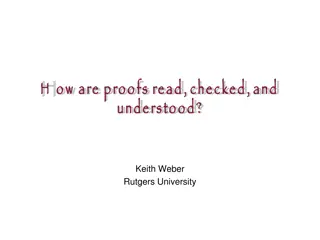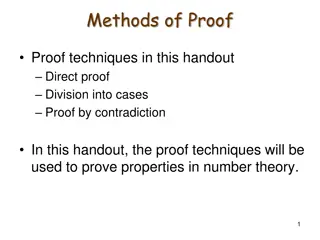Understanding Exhaustive Proofs and Proof by Cases in Discrete Math
Exhaustive proofs and proofs by cases are essential methods in discrete mathematics for proving theorems. Exhaustive proofs involve checking all possibilities, while proof by cases focuses on considering different scenarios separately. The methods are illustrated through examples like proving (n+1)^3 > 3n for n > 4 using exhaustive proof and demonstrating proof by cases to establish the validity of n^2 > n for integer values.
Download Presentation

Please find below an Image/Link to download the presentation.
The content on the website is provided AS IS for your information and personal use only. It may not be sold, licensed, or shared on other websites without obtaining consent from the author. Download presentation by click this link. If you encounter any issues during the download, it is possible that the publisher has removed the file from their server.
E N D
Presentation Transcript
Discrete Math: Exhaustive Proof and Proof by Cases
Exhaustive Proof and Proof by Cases Sometimes we cannot prove a theorem using a single argument that holds for all possible cases. We now introduce a method that can be used to prove a theorem, by considering different cases separately. This method is based on a rule of inference that we will now introduce. To prove a conditional statement of the form (p1 p2 pn) q the tautology [(p1 p2 pn) q] can be used as a rule of inference. [(p1 q) (p2 q) (pn q)]
Exhaustive Proof and Proof by Cases This shows that the original conditional statement with a hypothesis made up of a disjunction of the propositions p1, p2, . . . , pn can be proved by proving each of the n conditional statements pi q , i = 1, 2, . . . , n, individually. Such an argument is called a proof by cases. Sometimes to prove that a conditional statement p q is true, it is convenient to use a disjunction p1 p2 pn instead of p as the hypothesis of the conditional statement, where p and p1 p2 pn are equivalent.
EXHAUSTIVE PROOF Some theorems can be proved by examining a relatively small number of examples. Such proofs are called exhaustive proofs, or proofs by exhaustion because these proofs proceed by exhausting all possibilities. An exhaustive proof is a special type of proof by cases where each case involves checking a single example. We now provide some illustrations of exhaustive proofs.
EXHAUSTIVE PROOF: Example & Solution Prove that (n+1)3 3n if n is a positive integer with n 4. We use a proof by exhaustion. We only need verify the inequality (n + 1)3 3n when n= 1,2,3,and 4. For n=1, we have(n+1)3 = 23 = 8 and 3n = 31 = 3; for n = 2, we have (n+1)3 =33 = 27 and 3n =32 = 9; for n = 3, we have (n+1)3 =43 = 64 and 3n = 33 = 27; and for n = 4, we have (n+1)3 = 53 = 125 and 3n =34 = 81. In each of these four cases, we see that (n + 1)3 3n. We have used the method of exhaustion to prove that (n+1)3 3n if n is a positive integer with n 4.
PROOF BY CASES A proof by cases must cover all possible cases that arise in a theorem. We illustrate proof by cases with a couple of examples. In each example, you should check that all possible cases are covered.
PROOF BY CASES : Example & Solution Prove that if n is an integer, then n2 n. We can prove that n2 n for every integer by considering three cases, when n = 0, when n 1, and when n 1. We split the proof into 3 cases because it is straight forward to prove the result by considering 0, positive integers, and negative integers separately. Case(i):When n=0, because 02 =0, we see that 02 0. It follows that n2 n is true in this case. Case (ii): When n 1, when we multiply both sides of the inequality n 1 by the positive integern, we obtain n n n 1. This implies that n2 n for n 1. Case (iii): In this case n 1. However, n2 0. It follows that n2 n. Because the inequality n2 n holds in all three cases, we can conclude that if n is an integer, then n2 n.
References Discrete Mathematics and Its Applications, McGraw-Hill; 7th edition (June 26, 2006). Kenneth Rosen Discrete Mathematics An Open Introduction, 2nd edition. Oscar Levin A Short Course in Discrete Mathematics, 01 Dec 2004, Edward Bender & S. Gill Williamson























